When self-driving cars run over people, and our gadgets require more and more electricity, I want to ask a question. What's wrong with the electronics? Is her long tail bothering her?

Brainstorming part 1
After a series of unsuccessful attempts to create autonomous vehicles and complex IoT devices, executives and leading developers gathered to talk about what we are doing wrong. We can discuss this for hours in the comments, but let's give the floor to the experts, isn't it more productive?

The following people gathered to discuss these important issues:
- Steve Mensor, VP of Marketing Achronix
- Apuwa Kalia, Vice President of Research and Development Cadence
- Mohamed Kassem, CTO, efabless.com
- Matthew Balan, Process Engineer and Process Engineer at Mentor, Siemens Business
- Tom Anderson, Technical Marketing Consultant for OneSpin Solutions
- Andrew Dauman, VP of Technology, Tortuga Logic
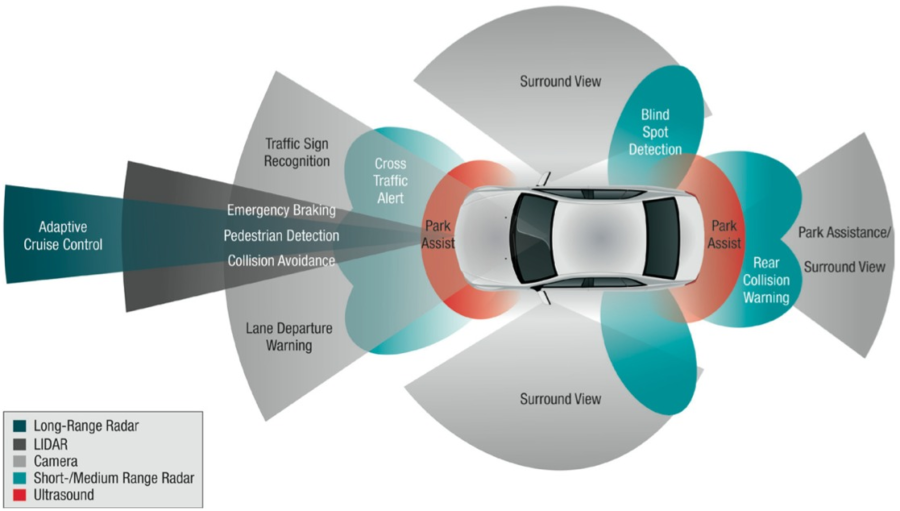
The ADAS system is striking in the number of sensors, radars and lasers.
Apuva Kalia:
Indeed, over the past 20 years, mobile phones have greatly influenced the design of electronics. And it will take a long time to reduce this trend. The mobile phone is still the driving force behind new developments, but something interesting is happening. If you look at a device such as ADAS (advanced driver-assistance systems, a premium sensor system designed to make driving safer and easier), you will see that this application is great for migrating from a mobile platform to any other. There are many new mobile technologies, the design and validation methodologies of which have become formalized and mature, and they can be applied to automatic vehicle projects.
Mohamed Kassem:
We have spent a lot of time integrating all the functions into a mobile phone to keep it as small as possible and to achieve low power consumption. We made a whole out of many small parts. Now we need to disassemble it again into different parts, into universal modules for various purposes. The phone is the benchmark for the IoT (Internet of Things) device. If we could reduce it to a point, then we would get the perfect module for solving any problem. But we cannot.
Andrew Dauman:
The mobile phone has advanced all technologies. He managed the implementation, he managed the validation, technology nodes, and the need for low power. But since we want to take it apart again, so that each module takes its own niche in its market segment, then each separate part will not receive as much attention and control. No new development will receive as much attention and importance as the development of a mobile phone. Only what really worries you changes. Self-propelled vehicles require stability, constant and complete inspection, and safety is critical. But do they get it all?
Apuva Kalia:
The mobile phone is more important than the autonomous vehicle. But it might be worth talking about the vague concept of the IoT. In terms of market size, it can outperform phones.
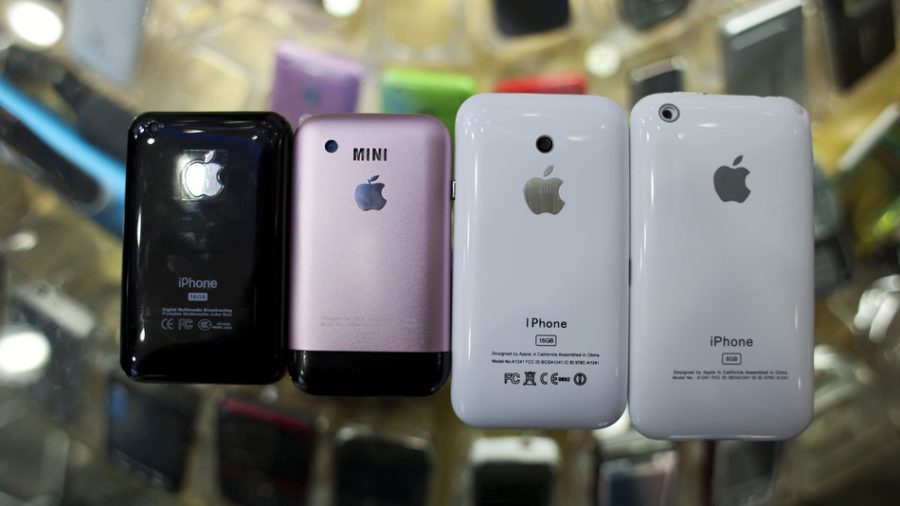
The longest tail is iPhone. Moreover, it is almost all pirate.
Mohamed Kassem:
If we take the e-book market as an example, we see a 'long tail'. The bestseller sells in millions of copies, and then you have a very long tail of ordinary gadgets, where the number of sales is only thousands of copies. At the same time, the total sales volume is such that you cannot afford to develop new products; all the profits have been eaten by the 'tail'. And if you have no profit, then you cannot afford to develop new products due to the risk of small sales. After all, you don't know what the next product will 'shoot'. Look at the number of similar e-books on Amazon, which one is better?
Tom Anderson:
Products should be different.
Mohamed Kassem:
This difference could be that one of the products has the best battery life. The market will determine the volume itself and show the best sellers. The GoPro Extreme Camera was created by a surfer and has gone from long tail to bestseller.
Matthew Balan:
Long Tail is driven by technology that can be reused or remixed. A mobile phone is a product based on existing technologies; you are not developing technologies, but only a product. There are no ready-made technologies for the Internet of Things (IoT) device, and everyone is forced to develop new ones that will change unpredictably.
Steve Mensor:
FPGAs (field programmable gate arrays) have a very 'long tail' and have driven the market for the past 15 years. Among all FPGA logic systems, the most important is its wireless part, it moves the entire ASP structure forward (everything related to the Internet, creating and reading pages, creating tools for creating them, etc.). With regard to data centers, we see the success of the Catapult project (a platform for improving the quality of life of women of any age by establishing communications between their projects and stakeholders). But if we look at this as a proxy, then we see a programmable hardware tool for managing the 'long tail'. All it takes for programmable logic to sell in high volume is the optimal balance of power and cost. Thoughtless use of FPGA systems can lead to a four- and five-fold increase in the price of a product. But we forgot about the individual FPGA elements (Fpga). They can be varied depending on the tasks, you do not need to buy the entire system as a whole, you just build what you need. How does this affect IoT development? At some point, you look at programmable sequential solutions – processors and say that this is normal (with a hint that it is not normal). And our programmable logic suggests building solutions for performing specific specific tasks (this is a clear stone in the garden of the creators of the first IoT prototypes, smart kettles and other refrigerators that use low-power ARM Cortex M3 and M4 processors) that will be optimal.
Tom Anderson:
There is a tendency to think of IoT development as something simple, where it all comes down to combining ready-made components into one device. But this is not the case. I've seen a lot of sophisticated circuits, including circuits with Fpga. I saw the diagram Intel Atom, but I was told that the work does not use software for the x86 architecture. The use of eight cores Intel in the IoT product is clearly redundant, but it is necessary to access the server capabilities of the chip. This is a heavy design.
Apuva Kalia:
One of the reasons why the development of the IoT is stuck is that any electronics, including smartphones and ADAS, began to be developed systematically, and the development of IoT stopped at the level of developing a single device. The end-device creators dumped all the solution development work on the vendors. (This means that the 'wishes' of developers of new electronics, including IoT and autonomous transport, do not correspond to the capabilities of the manufacturer of the 'hardware.' That is, the inventor makes a prototype of a smart kettle and stuffs it with self-made electronics, which for reasonable money does not repeat).
Mohamed Kassem:
All components existed off the shelf before the smartphone itself. The smartphone controls pre-existing components, including screens and batteries. But when you create a fundamentally new device, you have to do optimization. It may be advisable not to use off-the-shelf components, but to switch to ASIC (Special Purpose Integrated Circuit). The requirement for low power consumption makes its own adjustments.
Tom Anderson:
There are IoT devices that are inherently nothing more than simple sensors, but they are present in all industries.
Mohamed Kassem:
We must make the autonomous transport and IoT market highly profitable, and creating a universal platform can help in this.
Andrew Dauman:
There is a misconception that IoT devices are small. But look at a self-driving car – it's a very large, heavy, high-risk, impact-resistant IoT device. It has sensors and will communicate with its neighbors.
Apuva Kalia:
These will be the most sophisticated IoT devices in existence. They are not at all small and very difficult.
Tom Anderson:
Right! An autonomous vehicle is part of the IoT.
Mohamed Kassem:
Except that I don't think there will be 3 billion cars built and they can take over the market.
Tom Anderson:
The biggest evolution in electronics has come in the area of user safety. The people who came up with pacemakers and rockets already thought about it then. And even then they made their devices reliable, worried about alpha particles, and so on. In our time, suddenly it has become a part of everyday life. An autonomous vehicle must be subject to the same reliability and safety requirements as a pacemaker.
Apuva Kalia:
The trend towards safety in the automotive industry has been driven by market conditions. Safety in the car became an additional option that the buyer could pay for. And only then I entered the required minimum of the complete set. When you talk about a rocket or a pacemaker, the traditional way of ensuring safety is through redundancy. You simply install two sets of equipment instead of one, and this has almost no effect on the final cost of the rocket. The situation with the pacemaker is different, the reservation of systems will change its price from $ 200 to $ 400. This is also not a big problem. But if you take a $ 20,000 car with electronics worth $ 5,000, and you reserve the system, then the cost of the electronics alone rises to $ 8,000. This is a noticeable difference. This poses new challenges for developers how to ensure security without resorting to redundancy.
Mohamed Kassem:
The electronics in the car didn't fundamentally change until we started adding sensory systems.
Andrew Dauman:
Security and fault tolerance can be achieved by triple duplication of each module. However, there is a fact that security and protection technologies are not related in any way. With this approach, we are faced with the problem when, after solving security problems, someone makes changes to the device to solve security problems, and then fault tolerance and security can disappear. It is high time to combine all these things when developing devices, today we do not do this, which is bad.
Mohamed Kassem:
There are several disciplines. When designing a chipset, you don't get too distracted. But as you design your device further, you may need medical knowledge, 3D design, electronic design, or both. The ability to combine multiple disciplines is essential.
Tom Anderson:
You have a multi-level, multi-disciplinary thing, but you also have horizontals, including validation and security, which makes the matrix very complex.
Apuva Kalia:
Let's go back to autonomous driving. As we saw 15 years ago with the advent of the smartphone, the complexity of a problem far outstrips the ability of humans to grapple with complexity. People trying to solve these problems are still in the early stages of building their capacity to solve them.
Mohamed Kassem:
There is a lot of trial and error. We must keep experimenting and learning.
Apuva Kalia:
There is a massive shift of engineers from building mobile devices to the likes of IoT and autonomous transport. All designers who have been successful in designing mobile devices mistakenly believe that this will be an easy transition. I have had many conversations with people who have a chipset that is great for mobile devices and they want to turn it into an ADAS system …
This concludes the first part of the discussion. Friends, write whether it is worth publishing the second part upon its release. Curious about what the developers' heads are up to? Also share your thoughts on how to spend more energy and money. Should we create some kind of universal platform (with uniform standards for all manufacturers) or develop new unified components and add them to the device as needed? Or shrink the smartphone to the size of a match head and hand over all the reins to it? And what about the long tail?
Link to original discussion: Semiconductor Engineering
The fastest and most economical bluetooth

The Canadian company Spark Microsystems has presented to the public a new revolutionary digital radio module (analogue Bluetooth). The new technology is still being tested, and the prototype is made according to the old (but cheap) 65 nm TSMC process technology. Why did you need to develop a new BLE (energy efficient Bluetooth) module? Frederic Nabki, the father of the new transceiver, answers this question: 'When you use AirPods, about 80% of the charge will be spent on maintaining the device itself, and not on sound transmission. This is not the most efficient approach. '
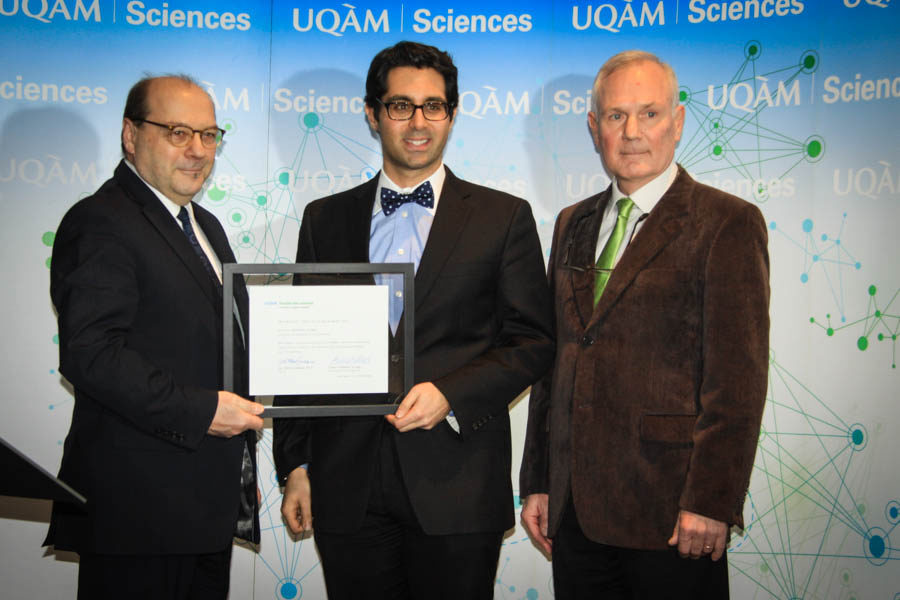
Frederic Nabqi (center)
The company has developed a transceiver (and microcontroller) called the Spark SR1000, which has ultra-low power consumption and ultra-short latency. The module consumes electricity 20 times less than the best competitors, and 35 times less on average in the BLE market. Energy savings are achieved by the record-breaking time to turn the module on and off, in just 50 microseconds versus 3 milliseconds from competitors. The radius of stable reception and transmission is 50 meters, and the broadcast is in the 'free' unlicensed band from 3 to 6 GHz. The maximum data transfer rate is 10 Mbps versus 1 Mbps for all competitors.
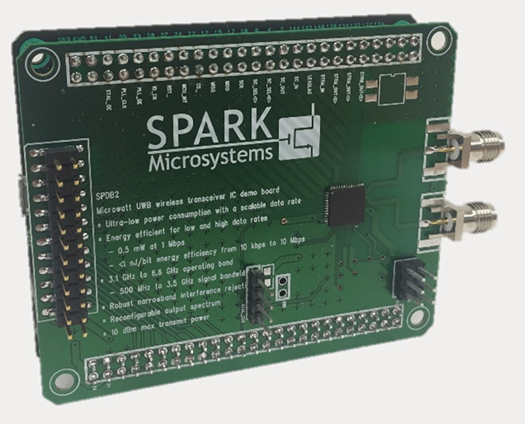
The electricity demand of the new module is so low that it can be provided by a small solar battery or Peltier element (converts heat into electricity), and when using standard batteries, it will work for a very long time. As mentioned above, the new module does not work in the standard frequency range, so it is possible to receive and send information only when both devices are manufactured by Spark Microsystems. The advantages are obvious – the unused frequency range is not clogged with interference, which contributes to a stable connection. Frederic hopes that the new range will eventually become de facto standard and other manufacturers will start using it (giving Frederick a percentage). Spark SR1000 will appear in the price lists of component suppliers in 2019, which means that we will see smartphones with it at the same time. All the advantages of the new technology are shown in the table:
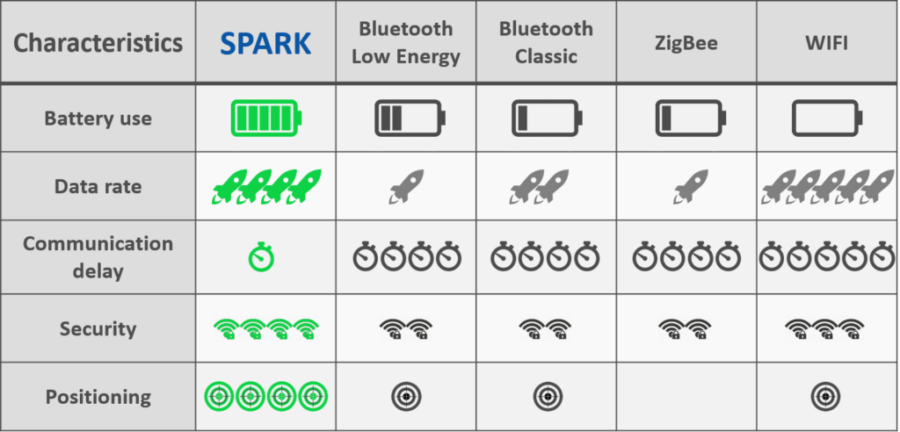
I also note that this is the first device that consumes electricity at threshold values (when the device cannot determine whether it consumes something or not), which means it is more than suitable for the Internet of Things (IoT), smartphones, headsets, etc. .
Friends, 10 Mbps will allow you to transmit the best quality sound? What do you think?
That's all the news for today. Summer is coming and many will get on their bicycles. They have not changed fundamentally for many, many decades, but we continue to use them. Will it be the same with smartphones and smart kettles? I don’t think so. And you?
